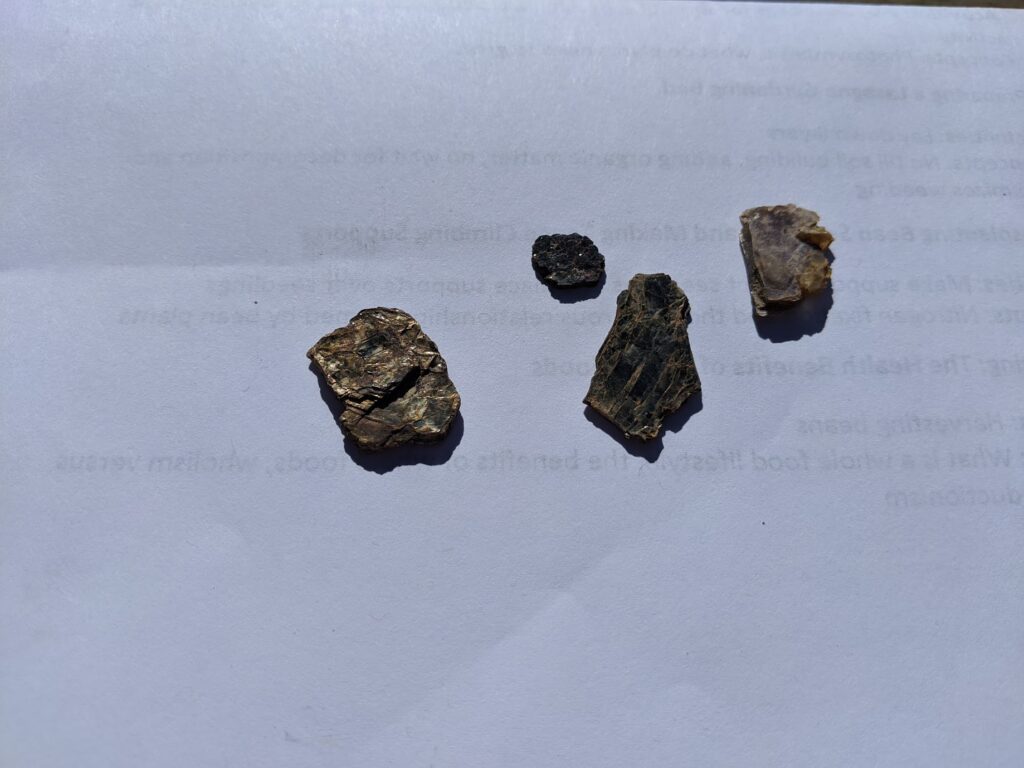As I discussed in a previous tip, one of the major components of soil is particles of weathered (i.e., broken down) rock (along with water, air, organic matter and living organisms). In this activity we’re going to focus on sorting the rock particles that makes up most of our soil. We’ll also look deeper into the nature of these particles.

This activity is suitable for any child old enough to either: (1) use their fingers or a toothpick to sort some soil particles with or without your help or, (2) is patient enough to watch you do the same. Your intermixed and follow-up conversations should start with your child’s observations and potentially build through their description of what they directly experienced and then an explanation of what they experienced.
The basic activity is to gather a Tablespoon of unamended soil from your yard, spill it out on a piece of white paper and sort it into at least three different piles. Younger children may only be able to pick out big pieces like little sticks or clumps of soil and that’s fine. Older children, capable of sorting individual sand-grains by color and texture should do that. There is no need to sort the whole Tablespoon. Just try and make sure that your little learning group gets to three or more piles with three or more particles in each.
As they are sorting ask children of any age to describe what they see and feel. You can also ask children of any age why they are putting each thing in each particular pile: “how are the things in the same pile the same?” And, “how are items in different piles different?” They may or may not be able to answer but asking can’t hurt as long as you are kind. You can also ask children to try and guess why the different grains of sand are different colors and textures. Make sure they know that you don’t expect them to know the answer and that you’re just asking for their thoughts and ideas. Older kids may be able to come up with answers like: “maybe they’re made of different stuff.” If they do, you can use the following technical background as needed to help them delve deeper into why the different grains of sand have different colors and textures.
Elements – The basic building blocks of everything!
Compounds – Combinations of elements bonded together.
Crystal – A compound with a specific microscopic arrangement that often results in particular kinds of macro (i.e., visible) structure. For example, mica minerals cleave easily into sheets.
Minerals – Solid natural occurring compound with a specific crystalline structure
Rock – A chuck of one or more specific minerals. Rocks are categorized based on the minerals they contain and who they are formed. Igneous rocks are formed when molten rock solidifies. Sedimentary rocks are formed when small particles settle in water and become cemented together. Metamorphic rocks are formed when either of the other two rock types or other metamorphic rocks are subjected to extreme heat and pressure.
Granite – The rock those of us living in California (and many of us living elsewhere as well) live on. A coarse-grained igneous rock formed largely of the minerals quartz and feldspar and also including mica and other minerals. Granite is an intrusive igneous rock, which means that it cools under the surface of the Earth. Because it cools under the Earth, it cools slowly, allowing it to form large visible grains of various minerals. The decomposed granite sand that makes up a large part of the soil you are sorting consists of grains of these minerals.
The pink grains in granite that you are likely to find in your soil sorting are orthoclase feldspar. Orthoclase feldspar is a pink mineral in the feldspar group of minerals. It is composed of potassium (the K in NPK fertilizers), aluminum, silicon, oxygen and hydrogen.
The clear, smoky and white grains are quartz or muscovite. Quartz is a very simple silicon dioxide mineral consisting mostly of silicon and oxygen. And more of its atoms are oxygen than silicon. Imagine that! A grain of sand that’s mostly oxygen. Quartz can also take on many different tints. Muscovite is a member of the mica family of minerals that is transparent to translucent with a golden tint. Like orthoclase feldspar, it contains potassium, aluminum, silicon, oxygen and hydrogen. Little muscovite flakes (along with the flakes of biotite, another mica mineral found in granite) create the almost glitter-like, sometimes golden, sparkles in decomposed granite soils).
The black grains can be biotite (a group of black micas) or hornblende (a group of black textured minerals). Biotite contains the elements potassium, magnesium, iron, aluminum, silicon, oxygen, hydrogen and fluorine. You might mention to the kids that have some idea what oxygen is, that most of the atoms in quartz and both the mica minerals, muscovite and biotite, are oxygen. Hornblende consists of the elements calcium, sodium, magnesium, iron, aluminum, silicon, oxygen, hydrogen and fluorine.
As always, please leave questions and comments below and, hey, be careful out there!